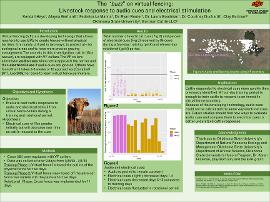| dc.contributor.author | Hays, Kendall | |
| dc.date.accessioned | 2023-05-12T21:38:08Z | |
| dc.date.available | 2023-05-12T21:38:08Z | |
| dc.date.issued | 2/13/2023 | |
| dc.identifier | oksd_hays_the_buzz_on_virtual_2022 | |
| dc.identifier.uri | https://hdl.handle.net/11244/337660 | |
| dc.description.abstract | Before the introduction of widescale ranching and European settlement in the new world, bison would graze freely across the landscape without manmade barriers like fencing. Today, ranching depends on stable fencing systems to ensure effective grazing management. Fences keep cows from overgrazing in a sensitive area or keep them in an area that needs to be grazed. However, traditional fencing systems can be very expensive and require a lot of labor to maintain and move. Further, in some parts of the US, fences can impede large-scale migrations of native ungulates like pronghorn (Antilocapra americana). The introduction of virtual fencing systems would help to eliminate some of the problems that come with traditional fencing systems. However, when you lack a physical boundary, it is unclear whether cows will stay within target areas. Virtual fencing uses GPS-enabled collars on cattle to understand their movement and grazing habits, but this technology also functions as a deterrent for crossing over virtual boundaries, using aural cues followed by electric stimulation. In this way, they function much like perimeter collars for dogs. For this study, we will use GPS data from cattle collars as well as information about sound triggers and electrical stimulation to determine 1) how long it takes individual cows to respond to aural cues alone, 2) how much variation there is among individual cows in sensitivity to aural cues and 3) overall effectiveness of aural vs. electrical stimulation. Information on cattle behavior will allow ranchers to identify individuals that are less receptive to virtual fencing, removing these from herds. Further, this research will allow us to understand lags in responsiveness to aural vs. electric cues, and how wide these digital boundaries must be to be effective. | |
| dc.format | application/pdf | |
| dc.language | en_US | |
| dc.rights | Copyright is held by the author who has granted the Oklahoma State University Library the non-exclusive right to share this material in its institutional repository. Contact Digital Library Services at lib-dls@okstate.edu or 405-744-9161 for the permission policy on the use, reproduction or distribution of this material. | |
| dc.title | "Buzz" on virtual fencing: Livestock behavior in response to audio cues and electronic stimulation | |
| osu.filename | oksd_hays_the_buzz_on_virtual_2022.pdf | |
| osu.accesstype | Open Access | |
| dc.type.genre | Honors Thesis | |
| dc.type.material | Text | |
| dc.contributor.director | Reuter, Ryan | |
| dc.contributor.facultyreader | Goodman, Laura | |
| thesis.degree.discipline | Natural Resource Ecology and Management | |
| thesis.degree.grantor | Oklahoma State University | |
